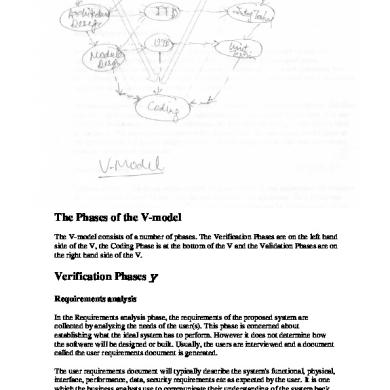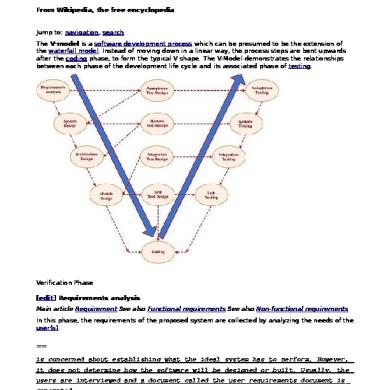V Model
This document was uploaded by user and they confirmed that they have the permission to share it. If you are author or own the copyright of this book, please report to us by using this DMCA report form. Report DMCA
Overview
Download & View V Model as PDF for free.
More details
- Words: 969
- Pages: 3
V-Model (software development) From Wikipedia, the free encyclopedia Jump to: navigation, search The V-model is a software development process which can be presumed to be the extension of the waterfall model. Instead of moving down in a linear way, the process steps are bent upwards after the coding phase, to form the typical V shape. The V-Model demonstrates the relationships between each phase of the development life cycle and its associated phase of testing.
Verification Phase [edit] Requirements analysis Main article Requirement See also Functional requirements See also Non-functional requirements In this phase, the requirements of the proposed system are collected by analyzing the needs of the user(s). ==
is concerned about establishing what the ideal system has to perform. However, it does not determine how the software will be designed or built. Usually, the users are interviewed and a document called the user requirements document is generated. The user requirements document will typically describe the system’s functional, physical,
interface, performance, data, security requirements etc as expected by the user. It is one which the business analysts use to communicate their understanding of the system back to the users. The users carefully review this document as this document would serve as the guideline for the system designers in the system design phase. The user acceptance tests are designed in this phase. [edit] System Design Main article Systems design System engineers analyze and understand the business of the proposed system by studying the user requirements document. They figure out possibilities and techniques by which the user requirements can be implemented. If any of the requirements are not feasible, the user is informed of the issue. A resolution is found and the user requirement document is edited accordingly. The software specification document which serves as a blueprint for the development phase is generated. This document contains the general system organization, menu structures, data structures etc. It may also hold example business scenarios, sample windows, reports for the better understanding. Other technical documentation like entity diagrams, data dictionary will also be produced in this phase. The documents for system testing is prepared in this phase. [edit] Architecture Design See also Computer architecture, Software architecture This phase can also be called as high-level design. The baseline in selecting the architecture is that it should realize all which typically consists of the list of modules, brief functionality of each module, their interface relationships, dependencies, database tables, architecture diagrams, technology details etc. The integration testing design is carried out in this phase. [edit] Module Design See also Modularity (programming) This phase can also be called as low-level design. The designed system is broken up in to smaller units or modules and each of them is explained so that the programmer can start coding directly. The low level design document or program specifications will contain a detailed functional logic of the module, in pseudocode - database tables, with all elements, including their type and size - all interface details with complete API references- all dependency issues- error message listingscomplete input and outputs for a module. The unit test design is developed in this stage. [edit] Validation Phases [edit] Unit Testing Main article Unit Testing In the V-model of software development, unit testing implies the first stage of dynamic testing process. According to software development expert Barry Boehm, a fault discovered and corrected in the unit testing phase is more than a hundred times cheaper than if it is done after delivery to the customer. It involves analysis of the written code with the intention of eliminating errors. It also verifies that the codes are efficient and adheres to the adopted coding standards. Testing is usually white box. It is done using the Unit test design prepared during the module design phase. This may be carried out by software testers, software developers or both. [edit] Integration Testing Main article Integration testing
In integration testing the separate modules will be tested together to expose faults in the interfaces and in the interaction between integrated components. Testing is usually black box as the code is not directly checked for errors. It is done using the integration test design prepared during the architecture design phase. Integration testing is generally conducted by software testers. [edit] System Testing Main article System testing System testing will compare the system specifications against the actual system. The system test design is derived from the system design documents and is used in this phase. Sometimes system testing is automated using testing tools. Once all the modules are integrated several errors may arise. Testing done at this stage is called system testing. [edit] User Acceptance Testing Main article Acceptance testing Acceptance testing: - To determine whether a system satisfies its acceptance criteria or not. - To enable the customer to determine whether to accept the system or not. - To test the software in the "real world" by the intended audience. Purpose of acceptance testing: - To verify the system or changes according to the original needs. Procedures for conducting the acceptance testing: Define the acceptance criteria: - Functionality requirements. - Performance requirements. - Interface quality requirements. - Overall software quality requirements. Develop an acceptance plan: - Project description. - User responsibilities. - Acceptance description. - Execute the acceptance test plan. [edit] Benefits The V-model deploys a well-structured method in which each phase can be implemented by the detailed documentation of the previous phase. Testing activities like test designing start at the beginning of the project well before coding and therefore saves a huge amount of the project time. [edit] References • • •
[edit]
Roger S. Pressman:Software Engineering: A Practitioner's Approach, The McGraw-Hill Companies, ISBN: 007301933X Mark Hoffman & Ted Beaumont: Application Development: Managing the Project Life Cycle, Mc Press, ISBN-10: 1883884454 Boris Beizer: Software Testing Techniques. Second Edition, International Thomson Computer Press, 1990, ISBN 1-85032-880-3
Verification Phase [edit] Requirements analysis Main article Requirement See also Functional requirements See also Non-functional requirements In this phase, the requirements of the proposed system are collected by analyzing the needs of the user(s). ==
is concerned about establishing what the ideal system has to perform. However, it does not determine how the software will be designed or built. Usually, the users are interviewed and a document called the user requirements document is generated. The user requirements document will typically describe the system’s functional, physical,
interface, performance, data, security requirements etc as expected by the user. It is one which the business analysts use to communicate their understanding of the system back to the users. The users carefully review this document as this document would serve as the guideline for the system designers in the system design phase. The user acceptance tests are designed in this phase. [edit] System Design Main article Systems design System engineers analyze and understand the business of the proposed system by studying the user requirements document. They figure out possibilities and techniques by which the user requirements can be implemented. If any of the requirements are not feasible, the user is informed of the issue. A resolution is found and the user requirement document is edited accordingly. The software specification document which serves as a blueprint for the development phase is generated. This document contains the general system organization, menu structures, data structures etc. It may also hold example business scenarios, sample windows, reports for the better understanding. Other technical documentation like entity diagrams, data dictionary will also be produced in this phase. The documents for system testing is prepared in this phase. [edit] Architecture Design See also Computer architecture, Software architecture This phase can also be called as high-level design. The baseline in selecting the architecture is that it should realize all which typically consists of the list of modules, brief functionality of each module, their interface relationships, dependencies, database tables, architecture diagrams, technology details etc. The integration testing design is carried out in this phase. [edit] Module Design See also Modularity (programming) This phase can also be called as low-level design. The designed system is broken up in to smaller units or modules and each of them is explained so that the programmer can start coding directly. The low level design document or program specifications will contain a detailed functional logic of the module, in pseudocode - database tables, with all elements, including their type and size - all interface details with complete API references- all dependency issues- error message listingscomplete input and outputs for a module. The unit test design is developed in this stage. [edit] Validation Phases [edit] Unit Testing Main article Unit Testing In the V-model of software development, unit testing implies the first stage of dynamic testing process. According to software development expert Barry Boehm, a fault discovered and corrected in the unit testing phase is more than a hundred times cheaper than if it is done after delivery to the customer. It involves analysis of the written code with the intention of eliminating errors. It also verifies that the codes are efficient and adheres to the adopted coding standards. Testing is usually white box. It is done using the Unit test design prepared during the module design phase. This may be carried out by software testers, software developers or both. [edit] Integration Testing Main article Integration testing
In integration testing the separate modules will be tested together to expose faults in the interfaces and in the interaction between integrated components. Testing is usually black box as the code is not directly checked for errors. It is done using the integration test design prepared during the architecture design phase. Integration testing is generally conducted by software testers. [edit] System Testing Main article System testing System testing will compare the system specifications against the actual system. The system test design is derived from the system design documents and is used in this phase. Sometimes system testing is automated using testing tools. Once all the modules are integrated several errors may arise. Testing done at this stage is called system testing. [edit] User Acceptance Testing Main article Acceptance testing Acceptance testing: - To determine whether a system satisfies its acceptance criteria or not. - To enable the customer to determine whether to accept the system or not. - To test the software in the "real world" by the intended audience. Purpose of acceptance testing: - To verify the system or changes according to the original needs. Procedures for conducting the acceptance testing: Define the acceptance criteria: - Functionality requirements. - Performance requirements. - Interface quality requirements. - Overall software quality requirements. Develop an acceptance plan: - Project description. - User responsibilities. - Acceptance description. - Execute the acceptance test plan. [edit] Benefits The V-model deploys a well-structured method in which each phase can be implemented by the detailed documentation of the previous phase. Testing activities like test designing start at the beginning of the project well before coding and therefore saves a huge amount of the project time. [edit] References • • •
[edit]
Roger S. Pressman:Software Engineering: A Practitioner's Approach, The McGraw-Hill Companies, ISBN: 007301933X Mark Hoffman & Ted Beaumont: Application Development: Managing the Project Life Cycle, Mc Press, ISBN-10: 1883884454 Boris Beizer: Software Testing Techniques. Second Edition, International Thomson Computer Press, 1990, ISBN 1-85032-880-3
Related Documents

V Model
June 2020 6
V Model
November 2019 35
V Spec Concept Model
June 2020 11
Testing V Model
June 2020 5
Msf Team Model V.3
November 2019 10
Model Model
April 2020 51More Documents from "Moch. Choirul Anam,S.Si"

Manual Testing Interview Questions
November 2019 35
Test Case And Use Cases
November 2019 31
Abhi
November 2019 38
Global Financial Crisis By Anil.j
May 2020 15
